英语教学法教程.ppt
合集下载
英语教学法教程全册配套PPT教学课件
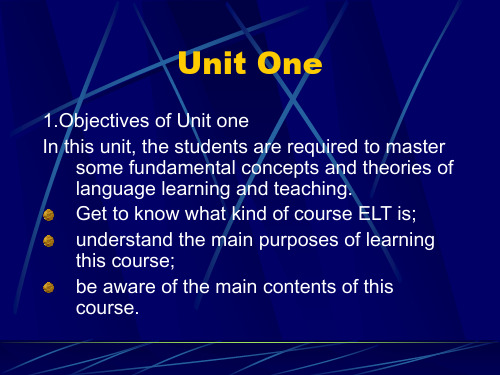
learning this course?
a. To provide learners with some current but basic theories related to language, language learning and language teaching.
b. To help learners develop practical skills and techniques in teaching the language.
e. To help learners develop their own ideas about ELT and the awareness of putting these ideas in their own teaching practice in the future.
3. What do you expect to learn or what do you want to learn from this course?
Teaching is a personal activity, and it is not surprising that individual teachers bring to teaching very different beliefs and assumptions about what constitutes effective teaching.
Howatt, A. P. R. A History of English Language Teaching. 上海:上海外语教育出版社, 1999.
Johnson, K. An Introduction to Foreign Language Learning and Teaching. 北京:外语教学与研究出版社, 2002.
a. To provide learners with some current but basic theories related to language, language learning and language teaching.
b. To help learners develop practical skills and techniques in teaching the language.
e. To help learners develop their own ideas about ELT and the awareness of putting these ideas in their own teaching practice in the future.
3. What do you expect to learn or what do you want to learn from this course?
Teaching is a personal activity, and it is not surprising that individual teachers bring to teaching very different beliefs and assumptions about what constitutes effective teaching.
Howatt, A. P. R. A History of English Language Teaching. 上海:上海外语教育出版社, 1999.
Johnson, K. An Introduction to Foreign Language Learning and Teaching. 北京:外语教学与研究出版社, 2002.
《王蔷英语教法》PPT课件.ppt

(3)导学课
• 共四次导学课 • 语音教学系统地址: http://218.19.140.194/main/index.jhtml • 可以通过网院主页 /index.html 左下方的“华师在线语音教学系统”进 入。
(4) BBS ( “交流园地”或“课程交流” )
内容
2、本课程的学习内容
Language and (language) Learning
Communicative Principles and Activities(and Task-Based Language Teaching) The National English Curriculum Lesson Planning Classroom Management Teaching Pronunciation Teaching Grammar Teaching Vocabulary
网络课件中的内容
• 课件中的主要内容:
– 精讲课:视频录像 + PPT – 期末考试模拟试题(附答案)两套 – 课外阅读材料(参考资料)。
关于网络课件中“课外阅读”的 材料
• 网络课件中“课外阅读”的材料内容不 会作为考试题目的知识点,但: • 建议同学们,尤其是已经在当英语教师 的同学们,要在适当的时候阅读,这对 英语教学实践和教研将有裨益。
The structural view
Sentences phrases Words Morphemes (the smallest meaningful unit) Phonemes (the smallest unit)
Top
The structural view
Syntactic system (phrases & sentences) …
《英语教学法教程》课件—01

(See the contents of the textbook)
II. Some Reference
books:
Brown, H. D. (1994a). Principles of Language Learning and Teaching. New York: Prentice Hall.
Teaching is a personal activity, and it is not surprising that individual teachers bring to teaching very different beliefs and assumptions about what constitutes effective teaching.
Methods based on this view
the Audio-lingual method Total Physical Response the Oral Approach Situational Language Teaching
The second view of language is the functional view, the view that language is a vehicle for the expression of functional meaning. The communicative movement in language teaching subscribes to this view of language. This theory emphasizes the semantic and communicative dimension rather than merely the grammatical characteristics of language, and leads to a specification and organization of language teaching content by categories of meaning and function rather than by elements of structure and grammar. The functional view not only sees language as a linguistic system but also a means for doing things. The English for Specific Purposes (ESP) movement begins not from a structural theory of language but from a functional account of learner needs(Robinson 1980)
II. Some Reference
books:
Brown, H. D. (1994a). Principles of Language Learning and Teaching. New York: Prentice Hall.
Teaching is a personal activity, and it is not surprising that individual teachers bring to teaching very different beliefs and assumptions about what constitutes effective teaching.
Methods based on this view
the Audio-lingual method Total Physical Response the Oral Approach Situational Language Teaching
The second view of language is the functional view, the view that language is a vehicle for the expression of functional meaning. The communicative movement in language teaching subscribes to this view of language. This theory emphasizes the semantic and communicative dimension rather than merely the grammatical characteristics of language, and leads to a specification and organization of language teaching content by categories of meaning and function rather than by elements of structure and grammar. The functional view not only sees language as a linguistic system but also a means for doing things. The English for Specific Purposes (ESP) movement begins not from a structural theory of language but from a functional account of learner needs(Robinson 1980)
《英语教学法教程》ppt课件
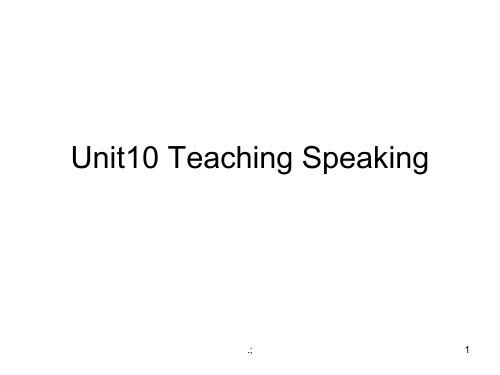
taught spoken language”?
• Speaking is the skill that the students will be judged upon most in real-life situations.
• Reasons: • It is an important part of everyday interaction
10
Making the best use of classroom leaning environment to provide sufficient language
input and practice for the students.
In china, students have the opportunity to hear and speak the language only in the classroom. So creating an English speaking environment to
2 Time-constraint
Full of time
3 Immediate feedback Need some time before feedback
6
10.2 Principles for teaching speaking
Aims: 1.Why do we teach speking? 2.What are the factors to affect the improvement of speaking ability ? 3.What are the principles for teaching speaking?
.;
7
The purpose of learning speaking
• Speaking is the skill that the students will be judged upon most in real-life situations.
• Reasons: • It is an important part of everyday interaction
10
Making the best use of classroom leaning environment to provide sufficient language
input and practice for the students.
In china, students have the opportunity to hear and speak the language only in the classroom. So creating an English speaking environment to
2 Time-constraint
Full of time
3 Immediate feedback Need some time before feedback
6
10.2 Principles for teaching speaking
Aims: 1.Why do we teach speking? 2.What are the factors to affect the improvement of speaking ability ? 3.What are the principles for teaching speaking?
.;
7
The purpose of learning speaking
英语教学法(教学PPT)
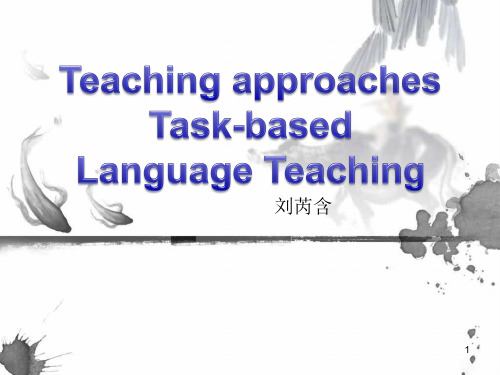
picture .This kind of activity can be called
an exercise-task.
9
Examples of the tasks
• Listening to a weather forecast and deciding what to wear
• Look at a set of pictures and decide what should be done
• Responsing to a party invitation • Completing a banking application • Describing a photograph of one's family
10
The real and unreal tasks in TBLT
• P:Where's the pen ?
3
Definitions of a task
• A task is an activity which requires learners to arrive at an outcome from given information through some process of thought, and which allows teachers to control and regulate that process.Prabhu said.
• Tasks are activities where the target language is used by the learner for a communicative purpose in order to achieve an outcome.Willis said.
英语教学法(教学PPT)

13
• S1:Which do you prefer ,tea or coffee ?
• S2:I prefer coffee./I prefer tea./I like them all./I don't like either .
• The activity is not merely reacting to the questions .But it is not a really task .It depends on the teacher's choices.
• Input:Questionnaire on sleeping habits • Activity:1)Reading questionnaire 2)Asking
and answering questions about sleeping habits • Teacher role:monitor and facilitator;to specify what is regarded as successful completion of the task • Learner role :conversational partner
15
An example in TBLT
• 语言结构:This is ... • 语言功能:指定与介绍(indentification
and introduction) • 1.学生模拟产品讲解员(或商店售货员)向
顾客介绍产品(或商品)简单描述用途:
• This is a thermometer.It is used to measure temperetures.
• 适用于我国英语教学现状的“任务型”教学法
任务是可称之为“中间型”教学任务
• S1:Which do you prefer ,tea or coffee ?
• S2:I prefer coffee./I prefer tea./I like them all./I don't like either .
• The activity is not merely reacting to the questions .But it is not a really task .It depends on the teacher's choices.
• Input:Questionnaire on sleeping habits • Activity:1)Reading questionnaire 2)Asking
and answering questions about sleeping habits • Teacher role:monitor and facilitator;to specify what is regarded as successful completion of the task • Learner role :conversational partner
15
An example in TBLT
• 语言结构:This is ... • 语言功能:指定与介绍(indentification
and introduction) • 1.学生模拟产品讲解员(或商店售货员)向
顾客介绍产品(或商品)简单描述用途:
• This is a thermometer.It is used to measure temperetures.
• 适用于我国英语教学现状的“任务型”教学法
任务是可称之为“中间型”教学任务
英语教学法教程PPTunit3
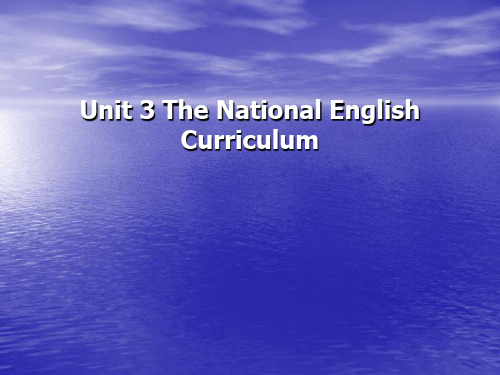
Unit 3 The National English Curriculum
• Objectives:
•l
Get the students to know about the background of
the design of the National English Curriculum.
•l
• Linguistic knowledge: Phonetics;
Vocabulary; Grammar; Functions; Topics
• Language skills: Listening; Speaking;
Reading; Writing
• Cultural awareness: cultural knowledge;
The new curriculum is designed to promote students’ overall language ability, which is composed of five interrelated components, namely, language skills, language knowledge, affects, learning strategies and cultural understanding. Each component is further divided into a few sub-categories. Language teaching is no longer aimed only for developing language skills and knowledge, but expanded to developing learners’ positive attitude, motivation, confidence as well as strategies for life-long learning along with cross-cultural knowledge, awareness and capabilities.
• Objectives:
•l
Get the students to know about the background of
the design of the National English Curriculum.
•l
• Linguistic knowledge: Phonetics;
Vocabulary; Grammar; Functions; Topics
• Language skills: Listening; Speaking;
Reading; Writing
• Cultural awareness: cultural knowledge;
The new curriculum is designed to promote students’ overall language ability, which is composed of five interrelated components, namely, language skills, language knowledge, affects, learning strategies and cultural understanding. Each component is further divided into a few sub-categories. Language teaching is no longer aimed only for developing language skills and knowledge, but expanded to developing learners’ positive attitude, motivation, confidence as well as strategies for life-long learning along with cross-cultural knowledge, awareness and capabilities.
英语教学法教程PPTunit6
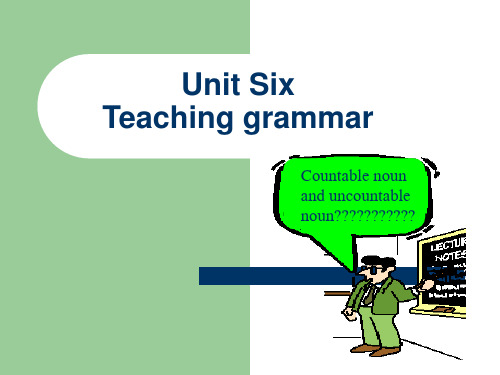
Example Two:
used to and be used to
1.They are derived from “use” (n.)习惯;惯例 e.g. according to an ancient use It is his use to take a shower every morning.
Summary Box
Adjeห้องสมุดไป่ตู้tive like boring and bored
Source or cause is –ing Things or people are Amusing, amazing, Astonishing, bewildering Frightening, horrifying Shocking, surprising Confusing, depressing Disappointing, disgusting
The party is really amazing. They are interested in the topic.
Mr.Smith is hard-working, though his work is a little boring. Sometimes he felt depressed when he could not finish it.
B. Inductive method Example One:
Discovering language:
Look at these two sentences. 1. Their guest’s name is Grolla. 2. Their daughters’ names are Hannah and Ella.
Teacher might be able to give greater emphasis to the –ed forms, providing or inviting examples in contexts where participants are affected(emotionally)by events. In this way, our learners might become more accurate when they decide to tell us how bored (or interested) they are in our classes.
英语教学法教程 课件

There is a Chinese saying that'Teachers are engineers of the soul'. This suggests that we are not just responsible for students' moral development. The word 'education' comes from the Latin verb educare, which means to'bring out'. In other words, teachers should try to bring out the full potential of their students as human beings, so they can live meaningful, fulfilling and responsible lives. At first glance, English language teaching may not seem an important area for moral learning. It is a foreign language and is sometimes associated with social values that are not shared by Chinese people. On the other hand, English lessons can provide excellent opportunities for a focus on moral values
Didactic model: students are explicitly and regelarly taught moral behaviour, as determined by the teacher.
英语教学法ppt课件

11
英语教学法及其相关学科
Байду номын сангаас理学对教学法的影响
1. 19世纪,20世纪初,心理学不发达 翻译法,直接法主导 2. 行为主义心理学- 听说法三个实践 A 桑代克(美)饿猫取食 B 巴甫洛夫 狗实验 C 斯金纳(美)白鼠实验 3. 认知心理学冲击 乔姆斯基语言学校理论生成
12
Homework
的方法创立的。 主张先开始听,然后才学习讲,然后
再学习读写。 教学原则: 外语是教学的语音,使用外语教授外
语。 只教授日常使用的词汇和句子。 听、说同时教。 强调正确的发音和句子语法的准确性。
22
2.4 20世纪西方的外语教学
1. 直接法有其不足之处 2. 英国的情景法建立 代表教材:《新概念英语》 3. 20世纪60年代后的西方外语教学
抄写一篇短文章,要求字迹工整
13
第二章 英语教学法简史
学习简史的目的: 1. 帮助我们了解不同历史阶段出
现过的外语教学法; 2. 了解这些教学方法出现的历史
背景,以及一种教学方法为什么 和怎么样被另一种教学方法所取 代。
14
2.1 古代和中世纪西方的外语 教学
在欧洲,拉丁语作为通用语延续 了几个世纪
16
拉丁语由教学语言变成一门课程, 地位下降
16至18世纪外语教学的特点: 一些学者和教育家对当时语言教
学实践不满并不断进行改革。
17
代表人物:
A 阿斯堪(英):重视古文教学, 以翻译作为主要教学手段
B 蒙田(法):提出用“自然法” 学习外语(去外国学习语言文化)
C 柯米尼亚斯(捷克):17世纪 最有影响的教育家,主张用“直 觉法”教学
5
常用的英语教学方法
英语教学法及其相关学科
Байду номын сангаас理学对教学法的影响
1. 19世纪,20世纪初,心理学不发达 翻译法,直接法主导 2. 行为主义心理学- 听说法三个实践 A 桑代克(美)饿猫取食 B 巴甫洛夫 狗实验 C 斯金纳(美)白鼠实验 3. 认知心理学冲击 乔姆斯基语言学校理论生成
12
Homework
的方法创立的。 主张先开始听,然后才学习讲,然后
再学习读写。 教学原则: 外语是教学的语音,使用外语教授外
语。 只教授日常使用的词汇和句子。 听、说同时教。 强调正确的发音和句子语法的准确性。
22
2.4 20世纪西方的外语教学
1. 直接法有其不足之处 2. 英国的情景法建立 代表教材:《新概念英语》 3. 20世纪60年代后的西方外语教学
抄写一篇短文章,要求字迹工整
13
第二章 英语教学法简史
学习简史的目的: 1. 帮助我们了解不同历史阶段出
现过的外语教学法; 2. 了解这些教学方法出现的历史
背景,以及一种教学方法为什么 和怎么样被另一种教学方法所取 代。
14
2.1 古代和中世纪西方的外语 教学
在欧洲,拉丁语作为通用语延续 了几个世纪
16
拉丁语由教学语言变成一门课程, 地位下降
16至18世纪外语教学的特点: 一些学者和教育家对当时语言教
学实践不满并不断进行改革。
17
代表人物:
A 阿斯堪(英):重视古文教学, 以翻译作为主要教学手段
B 蒙田(法):提出用“自然法” 学习外语(去外国学习语言文化)
C 柯米尼亚斯(捷克):17世纪 最有影响的教育家,主张用“直 觉法”教学
5
常用的英语教学方法
英语教学法教程lectu幻灯片PPT
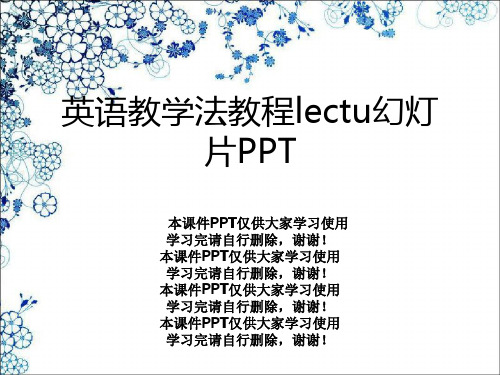
❖ It suggested that language is an intricate rulebased system and a large part of language acquisition is the learning of this system.
Constructivist theory
❖ 4. How can one become a good language teacher?
❖ 5. Try to explain “reflective model〞 in your own words.
Assignment:
语法翻译教学法(grammar-translation method〕 听说教学法 (Audio-lingual method) 交际教学法 (communicative language teaching
❖ As a teaching strategy, scaffolding is defined as the process by which an expert provides temporary support to learners to "help bridge the gap between what the learner knows and can do and what he or she needs to accomplish in order to succeed at a particular learning task.“
❖ It suggested language is a form of behavior and language learning involves the same procedure as an animal is trained to respond to stimuli.
Constructivist theory
❖ 4. How can one become a good language teacher?
❖ 5. Try to explain “reflective model〞 in your own words.
Assignment:
语法翻译教学法(grammar-translation method〕 听说教学法 (Audio-lingual method) 交际教学法 (communicative language teaching
❖ As a teaching strategy, scaffolding is defined as the process by which an expert provides temporary support to learners to "help bridge the gap between what the learner knows and can do and what he or she needs to accomplish in order to succeed at a particular learning task.“
❖ It suggested language is a form of behavior and language learning involves the same procedure as an animal is trained to respond to stimuli.
英语教学法教程PPTunit15

• Involving students and parents, as well as other personnel in the assessment process;
• Be an ongoing part of every day.
V. Testing in Assessment
• Questions and answers • True or false questions • Multiple-choice questions • Gap-filling completion • Matching questions • Dictation • Transformation • Translation • Essay writing • Interview
IV. Assessment Principles
• Assess authentic use of language in reading, speaking, listening and writing;
• Assess literacy and language in a variety of contexts;
assessment; - to understand the role of testing in
language assessment
I. Assessment Purpose
The people involved in education have some reasons to consider assessment necessary:
II. Assessment Methods
• Teacher’s assessment • Continuous assessment • Students’ self-assessment • Portfolios
英语教学法 PPT

• British Structuralism was based on LeviStrauss' Structuralism but was more empirical in approach.
• Many famous Linguists (H. Palmer/ A. S.Hornby) analysis and summary of the main English grammatical structure together and summarized them as certain sentential form .
evidences for the paraphrasing.
Contextual learning
• United Kingdom anthropologists B. Malinowski(马林若夫斯基)and linguist J. R. Firth(弗斯)proposed ;
• Three features: features related participant 、 relative purpose 、effect of verbal behavior .
• Language is speech, not writing so that speaking than writing priorities study ;
• Take advantage of contrastive analysis to study.
British Structuralism(英国的结构主义)
American Structuralism(美国的结构主义)
• The background of American Structuralism • The three period of American Structuralism • Features of American Structuralism • Advantages of American Structuralism • Problems of American Structuralism • Methods of American Structuralism
• Many famous Linguists (H. Palmer/ A. S.Hornby) analysis and summary of the main English grammatical structure together and summarized them as certain sentential form .
evidences for the paraphrasing.
Contextual learning
• United Kingdom anthropologists B. Malinowski(马林若夫斯基)and linguist J. R. Firth(弗斯)proposed ;
• Three features: features related participant 、 relative purpose 、effect of verbal behavior .
• Language is speech, not writing so that speaking than writing priorities study ;
• Take advantage of contrastive analysis to study.
British Structuralism(英国的结构主义)
American Structuralism(美国的结构主义)
• The background of American Structuralism • The three period of American Structuralism • Features of American Structuralism • Advantages of American Structuralism • Problems of American Structuralism • Methods of American Structuralism
- 1、下载文档前请自行甄别文档内容的完整性,平台不提供额外的编辑、内容补充、找答案等附加服务。
- 2、"仅部分预览"的文档,不可在线预览部分如存在完整性等问题,可反馈申请退款(可完整预览的文档不适用该条件!)。
- 3、如文档侵犯您的权益,请联系客服反馈,我们会尽快为您处理(人工客服工作时间:9:00-18:30)。
The functional View
• The functional view sees language as a linguistic system and as a means for doing things.( Language is a vehicle to express or accomplish a certain function, such as requiring sth. Learner learn a language in order to be able to do things with it.)
•
words
•morphemeFra bibliotek(词素)• (the smallest meaningful unit)
•
phonemes(音素,音位)
• (the smallest unit)
The purpose of language learning
• To learn a language means to learn these structural items so as to be able to understand and produce language.
– rules of language form (grammar & vocabulary): to speak the language grammatical correctly
– rules of language uses in a context :Is it appropriate to use this item in this context or given situation?
• The structural view sees language as a linguistic system. (Language is a system of structuring related elements to code meaning, for example, grammar. Rf. A Course for ELT)
What is language?
• 语言的本质与语言教学的本质特征
– 语言的定义(definition of language) – 语言的本质特征 (nature of language)
• 交际工具 • 符号系统 • 思维工具和文化载体 • 特殊的生理基础
• (Views on the nature of language have an impact on the teaching / learning method of a person)
• 语言学习的目标被认为是掌握该系统中各 种成分,即音位、语法单位、词汇等)
Impact on language teaching
• Audiolingual approach (听说法) • Total Physical Method (全身反应法) • The Silent Way (沉默法)
Methodology of English Teaching
英语教学法
• “追求方法”:二十世纪八十年代之前 • “教无定法”:后方法时代
– 英语教学论是一门研究中小学英语教学目的、 教学内容、教学目标、教学过程、教学原则、 教学模式、教学科研的理论与实践的基本原理、 一般规律、主要方法等,以全面培养学生面向 未来的基础性的英语运用能力和基础性的综合 素质的学科。
Interactional View
• sees language as a communicative tool ( build up and maintain relations between people) 语言是实现人际关系和进行个人之间社会 交往的工具。
• Two things are needed for communication
• 语言的本质是由结构上相互联系的单位组 成的、用来表达一定意义的结构系统。
• The system of language=
•
the system of sound +
•
the system of words +
•
they system of grammar +
•
sentences
•
phrases
• 认为语言既是一个符号体系,也是一种交 际工具
• 语言是表达交际功能的载体。
• 强调语言的语义和交际特点,而不是语言 的语法特征
• 有意念-功能教学大纲(Notion-function Syllabus)
• 交际法教学
Functions of language
• E.g. • offering • suggestion • advising • apologizing • etc.
Introduction
• Brief Introduction of the Course and Course Plan
课程学习参考书目
Unit 1 Language and Learning
• View on language • Views on language learning • What makes a good language teacher?
Notion
• Purpose of using notion:
– To perform function
• What is notion
– rules and vocabulary are constructed to express notions
– Examples:
• Present time, past time and future time • Certainty and possibility • Agent and instrument • Relationship between people and objects
对语言教学本质的理解及其对教学实践的影响
Views on Lanuage
• The Structural View (结构主义) • The functional View(功能主义) • The interactional View(相互作用理论或交
互理论)
The Structural View
